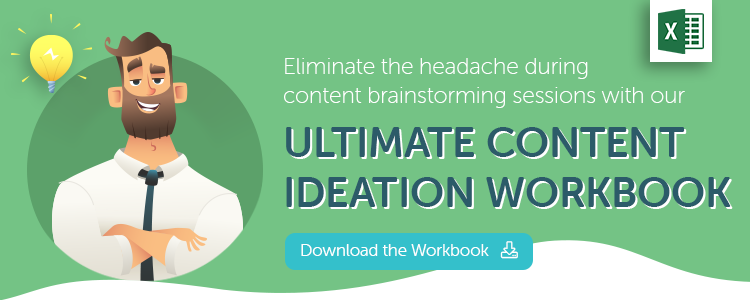Most B2B companies want to be seen as thought leaders in their space.
If you don’t clarify your vision for what thought leadership is, you may not be sure when you’ve reached it. Many people have differing ideas about what thought leadership entails or looks like.
In the long run, though, there are some things we can all agree on:
- Thought leadership is crystallizing your knowledge in a way your audience can use.
- Thought leadership clarifies why a certain way is better, not just how things are done.
- Thought leadership is distilled from the real insights and experience of individuals.
If you want to be a pioneer, you have to translate your knowledge capital into content that makes an impact. There’s no faster way to do it than to go to the source: Interviewing thought leaders.
With the results of a good interview, you’ll have the raw materials for exceptional content.
Unless you’ve got a background in journalism, however, odds are good you’ve never interviewed someone just to find out what they know. An interviewer’s role is to keep the conversation on track while being flexible enough to recognize opportunities for rare insight.
Here’s how you can get started:
1. Choose the Right Thought Leader
First, be sure you’re choosing the right thought leader for your project. If you’re interviewing in your organization, it’s usually easy to determine who has the most information on a topic.
If you’re going outside, do your research to pinpoint authorities who have a history of writing and speaking on the subject. LinkedIn is the perfect place to start searching for relevant thought leaders.
Aside from LinkedIn, you can also find thought leaders by reading online publications that fir the topic you're covering. For example, if you're looking for search engine marketing professionals, check out leading publications like Search Engine Watch and Search Engine Land.
Connect with authors via social media to request interviewing them for your content. Make sure you're upfront from the start of your correspondence, which leads to the next point.
2. Set the Tone From the Beginning
How you present your project will make a difference in how thought leaders respond – and whether they make time for you.
Instead of saying you want to “ask a few questions” or “pick their brains,” give them a timeframe (fifteen minutes, half an hour) as well as a date by which you’d like to speak. Provide a few background details on your project and why it matters.
If you have a general outline of your content, share that information with them and show where their expertise fits in. This way, they can come prepared to your interview.
3. Make Records of Your Conversation
A terrific interview is wasted if nobody remembers what was said.
Avoid the temptation to take notes while you talk. This breaks rapport and can cause your thought leader to disengage. Instead, ask early on if you’re permitted to record the meeting. A voice recorder app on your phone can make this easy.
If you do end up taking notes, write just enough to jog your memory. Once you get out of the interview, expand on notes to be sure you capture fine details. If you have follow-up questions, email them ASAP – but don’t forget to thank the interviewee, too.
4. Use Open-Ended Questions to Learn More
“Yes” or “no” questions get you nowhere. Plus, you can usually look up those answers yourself.
Open-ended questions are the key to getting thought leaders talking. When you show a genuine interest in what they have to say, they’ll usually help you by diving deep on topics that fascinate them the most. That, in turn, is where they have the deepest insight.
Open-ended questions can include:
- “How did you come to that conclusion?”
- “What is the most important thing about ...?”
- “What do you feel is the most interesting trend in ...?”
Inbound sales pros who conduct discovery sessions with their leads can help you get on the right track. Open-ended questions are what sales pros use to get others to “lower their shields” and provide details on their needs. You can build similar rapport with your interviewees.
Incidentally, starting questions with “What do you feel ...” helps interviewees see you’re focused on their perspective. This motivates them to take firmer stands on the issues.
5. Plan Key Topics You Want to Cover
Getting caught up in someone else’s enthusiasm can take you to places you don’t expect to go. Still, if you’re crafting content, you usually have some basic topic you want to touch on. You don't want the interview to go way off track.
Always start from these top-level ideas and then move down into your open-ended questions. Keep an eye on your allotted time and gently move your interviewee to the next topic as needed. Otherwise, you might run out of time and not get to the topics you really want to discuss.
6. Use Their Communication Preferences
The best interviews are face to face. Sometimes, though, that’s not possible.
If you’re working with a thought leader who has limited time or delves into complicated concepts, you can go with good old email. This is also ideal for introverts or those who communicate best in writing.
In most cases, avoid Skype or FaceTime: They offer few of the benefits of being in the same room.
Just remember this: Don’t think of interviewing as a stodgy, high-pressure event. Done right, it’s a conversation about whatever someone else is passionate about. That’s not only fun; it also gives you unique tools for outstanding content.


Rob Steffens
I am the Director of Marketing here at Bluleadz. I'm a huge baseball fan (Go Yankees!). I love spending time with friends and getting some exercise on the Racquetball court.